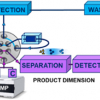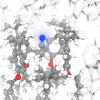
NIST/JILA fellows Jun Ye, David Nesbitt and their colleagues have demonstrated that a breathalyser based on frequency-comb technology combined with machine learning techniques can accurately detect SARS-CoV-2 infection in human breath. The frequency-comb technology has the potential to detect many other diseases, such as COPD, lung cancer and kidney failure. Frequency combs can precisely measure different wavelengths of light, including the infrared light absorbed by molecules in a person’s breath. Combined with machine learning, this technique can detect the presence of specific combinations of molecules that are signatures of disease.
Back in 2008, Jun Ye and colleagues at JILA demonstrated the world’s first frequency comb breathalyser, which measured the absorption of light in the near infrared part of the optical spectrum. In 2021 they achieved a thousand-fold improvement in detection sensitivity by extending the technique to the mid-infrared spectral region, where molecules absorb light much more strongly. This enables some breath molecules to be identified at the parts-per-trillion level where those with the lowest concentrations tend to be present.
The added benefit to this study was the use of machine learning to look at the data from all the breath samples as measured by 14,836 comb “teeth”, each representing a different wavelength or frequency to create a predictive model to diagnose disease.
“Molecules increase or decrease in their concentrations when associated with specific health conditions. Machine learning analyses this information, identifies patterns and develops reliable criteria we can use to predict a diagnosis”, said Qizhong Liang, a graduate student in the Jun Ye group.
“I do think that this comb technique is superior to anything out there”, NIST/JILA Fellow Jun Ye said. “The basic point is not just the detection sensitivity, but the fact that we can generate a far greater amount of data, or breath markers, really establishing a whole new field of ‘comb breathomics’ with the help of AI. With a database, we can then use it to search and study many other physiological conditions for human beings and to help advance the future of healthcare.”
The JILA comb breathalyser method demonstrated excellent accuracy for detecting COVID by using machine learning algorithms on absorption patterns to predict SARS-CoV-2 infection. H2O, HDO, H2CO, NH3, CH3OH and NO2 were identified as discriminating molecules for detection of SARS-CoV-2 infection.
In the future, the researchers could further increase the accuracy by expanding the spectral coverage, analysing the patterns with more powerful AI techniques, and measuring and analysing additional molecules, which could include the SARS-CoV-2 virus itself. Researchers would need to build a database of the specific IR wavelengths absorbed by the virus (its spectral “fingerprint”) to potentially measure viral concentrations in the breath.
The researchers also identified significant differences in breath samples based on tobacco use and a variety of gastrointestinal symptoms such as lactose intolerance. This suggests broader capability of the technique for diagnosing different sets of diseases.
The researchers plan further studies to try to diagnose other conditions such as chronic obstructive pulmonary disease, the third leading cause of death worldwide according to the World Health Organization. The researchers have also recently boosted the comb breathalyser’s diagnostic power by expanding the spectral coverage to detect additional molecules. They plan to employ additional AI approaches such as deep learning to improve its disease-detection abilities. Efforts are already under way to miniaturise and simplify the technology to make it portable and easy to use in hospitals and other care settings.










